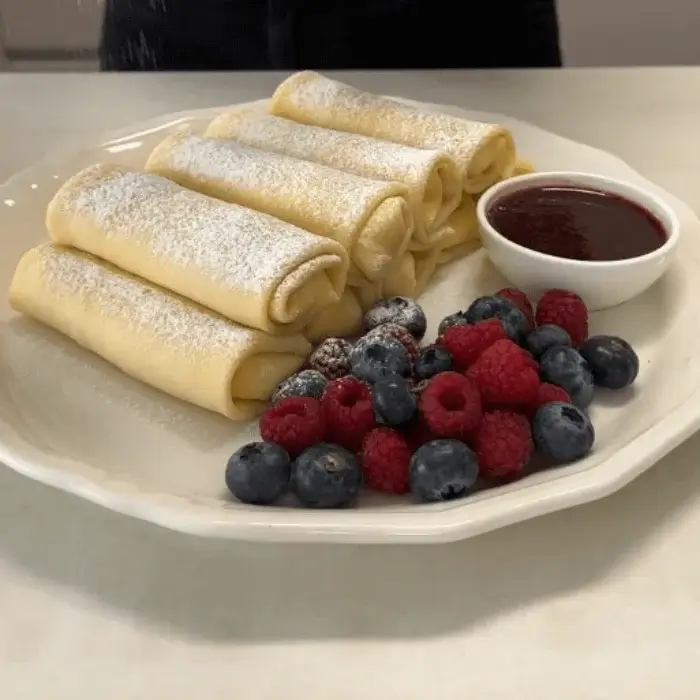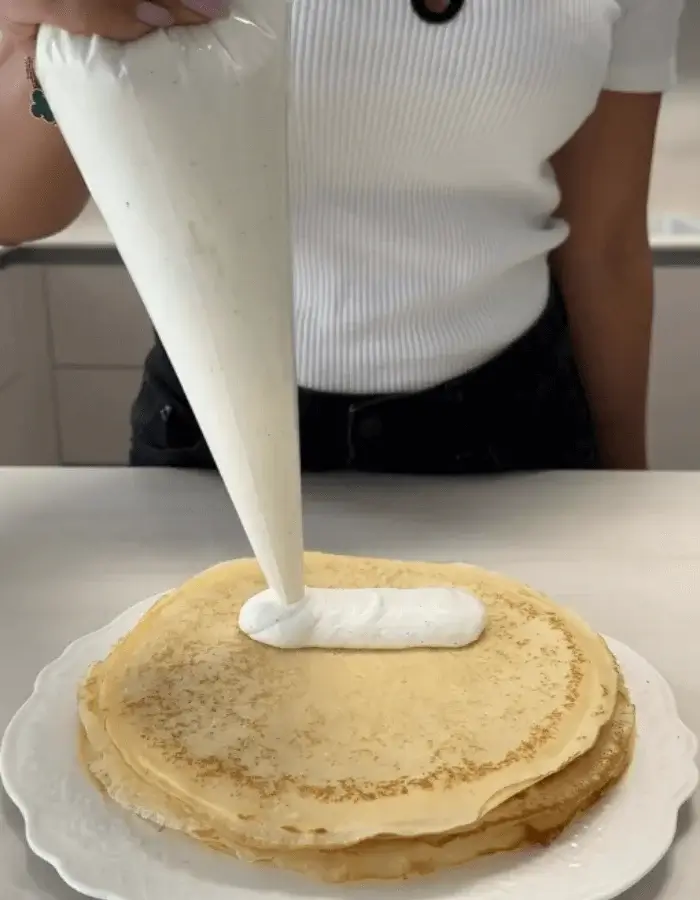Gluten Free Blintzes with Cheese
We may earn a commission from recommended products, at no extra cost to you. See Disclosure.
INGREDIENTS
- Butter for greasing the pan
- Fresh berries for serving
Batter:
- 4 large eggs
- 2 cups/480 milliliters milk
- ¼ cup/50 grams sugar
- ½ cup/70 grams cornstarch
- ½ cup/70 grams gluten-free flour or potato starch
- 1 cup/250 milliliters heavy cream
- 3.5 ounces/100 grams sour cream or ricotta
- 3.5 ounces/100 grams cream cheese
- ¼ cup/50 grams sugar
- 1 ½ tablespoons/14 grams vanilla instant pudding
- 1 teaspoon vanilla bean paste or seeds from 1 vanilla pod
INSTRUCTIONS
- In a large bowl, whisk together the eggs, milk, sugar, cornstarch, and gluten-free flour or potato starch until the batter is completely smooth. If any lumps remain, strain the batter through a fine mesh sieve.
- Heat a wide nonstick skillet over medium heat and lightly grease with butter. Pour in a small amount of batter and immediately swirl the pan to create a thin, even layer. Cook for about 40 seconds on each side, then transfer the crepe to a plate. Repeat with the remaining batter. Refrigerate the finished crepes until fully cooled and easy to handle.
- While the crepes chill, make the filling. In the bowl of a stand mixer fitted with the whisk attachment, combine the heavy cream, white cheese, cream cheese, sugar, vanilla pudding powder, and vanilla. Whip on medium speed until the mixture becomes thick and holds stiff peaks. Transfer the filling to a piping bag.
- Pipe a strip of filling along the bottom third of each crepe. Fold in the sides and roll up into a tight blintz. Refrigerate until ready to serve.
- Serve cold, topped with fresh raspberries or blueberries.
MY NOTES

FAQ
What is the best substitute for potato starch?
Arrowroot starch is a common substitute for potato starch in gluten free blintzes. Both are gluten-free, but arrowroot tends to create a slightly more delicate texture. If you choose to use arrowroot, you can replace potato starch in equal amounts. However, the batter may be a bit more fragile, so handle the crepes gently when cooking and rolling. You can also experiment with tapioca flour or cornstarch as alternatives, but each might affect the texture of the crepes in slightly different ways, so it’s best to test them out beforehand.

Can I use almond flour or coconut flour instead of gluten free flour?
Almond flour and coconut flour are not direct substitutes for gluten free flour in blintz recipes. Almond flour is denser and might result in a thicker batter, making it harder to achieve the desired thin, pliable texture for the crepes. Coconut flour, on the other hand, is highly absorbent and would require adjustments to the liquid content. Gluten free flour blends typically combine rice flour, tapioca flour, and other ingredients that mimic the properties of wheat flour, making them more suitable for the delicate nature of gluten free blintzes. If you choose almond or coconut flour, you may need to experiment to get the correct batter consistency.
How to prevent gluten free blintzes from tearing when rolling?
To prevent gluten free blintzes from tearing when rolling, it’s essential to use a light, smooth batter and cook the crepes until they are golden but still flexible. Allow the crepes to cool completely before handling them, as this helps them firm up slightly, reducing the risk of tearing. If your crepes tear easily, try adding a bit more cornstarch or potato starch to the batter to increase flexibility. Additionally, be sure to handle the crepes gently when folding or rolling, and ensure the filling is not too thick, as a thicker filling can make them harder to roll without breaking.
Is it possible to make these gluten free blintzes without dairy?
You can substitute the dairy in both the crepes and filling with non-dairy alternatives. For the crepes, replace regular milk with almond milk, oat milk, or any other plant-based milk. For the filling, use non-dairy cream cheese and coconut cream or a soy-based whipped cream as alternatives to the heavy cream and dairy cheeses. Ensure that the non-dairy products are thick and stable enough to create a creamy texture similar to traditional fillings.

Can I freeze gluten free blintzes and reheat them later?
After preparing the blintzes and allowing them to cool, place them in a single layer on a baking sheet and freeze until solid. Once frozen, stack them with parchment paper between each blintz and store them in an airtight container or freezer bag for up to 2 months. To reheat, you can either bake them in the oven at 350°F (175°C) for 10-15 minutes or reheat them on the stovetop over low heat. Be sure to let them thaw in the fridge overnight for the best texture before reheating.
Why is my batter lumpy and how can I fix it?
Lumpy batter is a common issue when making gluten free blintzes, especially when using starches and flours that may not mix as easily as wheat flour. To fix the lumps, whisk the ingredients thoroughly to create a smooth batter. If lumps persist, you can strain the batter through a fine mesh sieve to remove them. Another method is to mix the batter in a blender, which helps achieve a smooth consistency without any lumps. Additionally, letting the batter rest for 20-30 minutes can help the ingredients fully hydrate and create a smoother texture.
Do I need to rest the batter before cooking?
Yes, it’s a good idea to rest the batter for gluten free blintzes before cooking. Allowing the batter to sit for 20-30 minutes helps the starches absorb the liquid more evenly and improves the texture of the crepes. This resting period helps prevent the crepes from being too fragile and ensures they hold together better during cooking. It also allows the flour and cornstarch to fully hydrate, resulting in a smoother, more cohesive batter. If you’re in a rush, resting the batter for even just 10 minutes can make a noticeable difference in the crepes’ texture.

